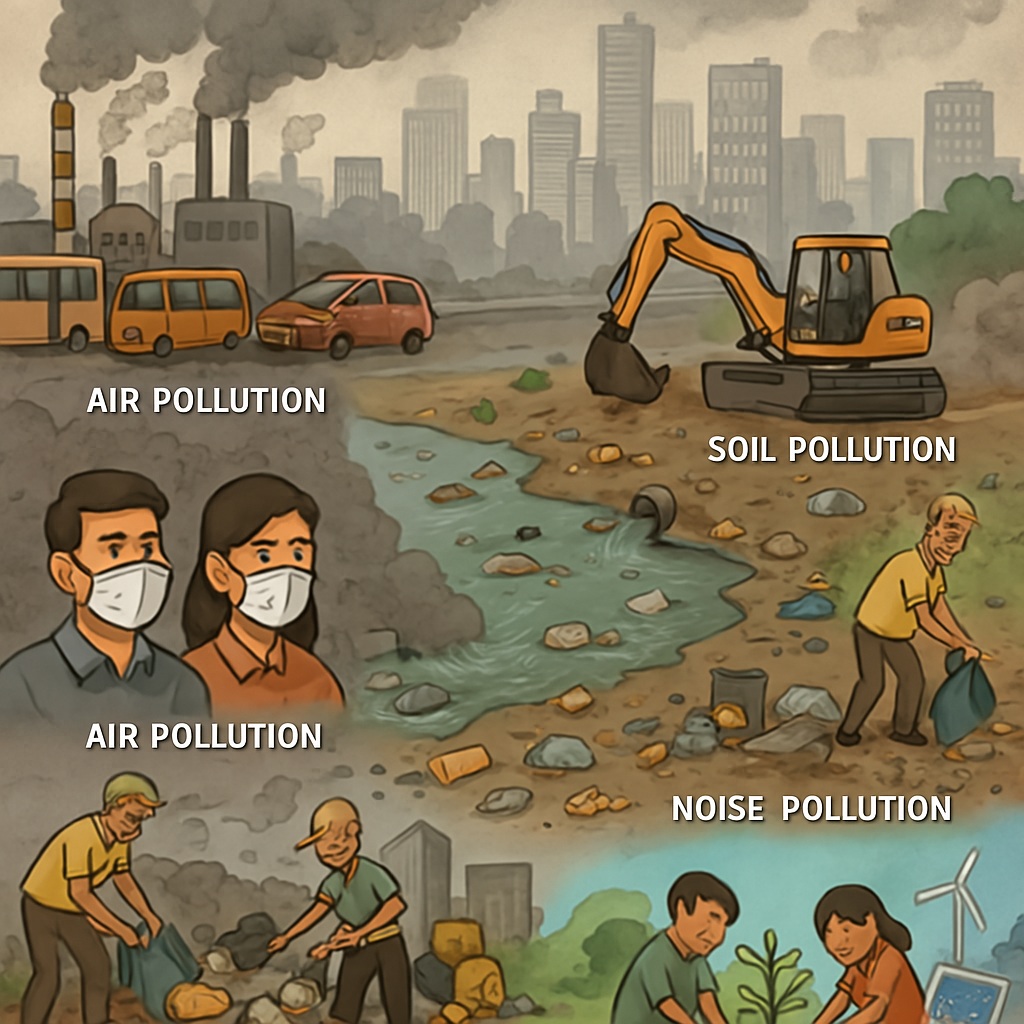Environmental pollution is one of the most pressing issues facing India today. Rapid industrialization, urbanisation, population growth, and unplanned development have led to the degradation of air, water, soil, and other natural resources. Pollution not only affects the environment but also poses serious risks to public health, agriculture, and economic development.

Table of Contents
Major Types of Pollution in India
Air Pollution
Air pollution is a severe problem in Indian cities like Delhi, Mumbai, and Kanpur. It is mainly caused by:
- Vehicular emissions due to increasing number of automobiles.
- Industrial smoke and use of fossil fuels like coal and diesel.
- Burning of crop residues in northern states (stubble burning).
- Construction dust and open waste burning.
Impact: It leads to respiratory problems, cardiovascular diseases, reduced visibility, and contributes to climate change.
Water Pollution
Many rivers in India, including the Ganga and Yamuna, are heavily polluted due to:
- Discharge of untreated sewage and industrial effluents.
- Agricultural runoff containing pesticides and fertilizers.
- Religious and cultural practices (e.g., immersion of idols, bathing).
Impact: It causes waterborne diseases like cholera and diarrhea, harms aquatic life, and makes drinking water unsafe.
Soil Pollution
Soil pollution is increasing due to:
- Overuse of chemical fertilizers and pesticides in farming.
- Dumping of plastic and non-biodegradable waste.
- Improper disposal of industrial and electronic waste.
Impact: It reduces soil fertility, contaminates crops, and affects food safety.
Noise Pollution
In urban India, noise pollution is a growing concern due to:
- Traffic congestion and honking.
- Construction activities and loudspeakers during festivals.
- Industrial machinery.
Impact: It leads to stress, hearing loss, and disturbed sleep patterns.
Key Issues and Challenges
- Public Health Crisis: Pollution contributes to a rising number of diseases, especially in children and the elderly.
- Environmental Degradation: Deforestation, loss of biodiversity, and poor waste management degrade the natural habitat.
- Economic Loss: Health care costs and loss of productivity due to pollution-related illnesses burden the economy.
- Policy Implementation Gaps: Despite environmental laws, poor enforcement and corruption weaken their impact.
- Lack of Public Awareness: Many people are unaware of pollution’s long-term consequences and how to reduce it.
Measures Being Taken
The Indian government and civil society have taken several initiatives:
- National Clean Air Programme (NCAP) to reduce particulate matter in polluted cities.
- Namami Gange Mission to clean and conserve the Ganga river.
- Swachh Bharat Abhiyan to promote cleanliness and reduce littering.
- Ban on single-use plastics in various states.
- Promotion of electric vehicles (EVs) and renewable energy sources like solar and wind.
Conclusion
Environmental pollution in India requires immediate and collective action. Strengthening environmental regulations, promoting green technology, raising public awareness, and encouraging individual responsibility are essential to protect the country’s natural resources and ensure a healthy future for all citizens.
Read: Geography Notes